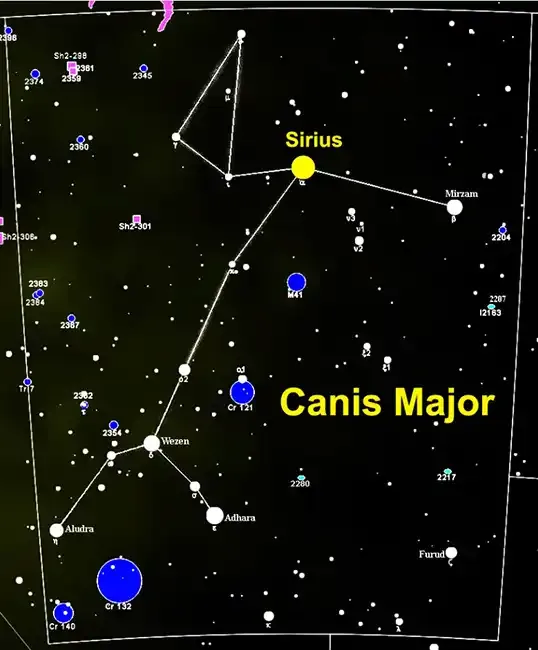
Canis Major, Latin for "Greater Dog," is one of the most prominent constellations in the night sky. It is located in the southern celestial hemisphere and is easily recognizable due to its brightest star, Sirius, also known as the "Dog Star." Canis Major represents the larger of the two dogs that follow Orion, the hunter, in Greek mythology. The constellation is rich in notable stars and deep-sky objects, making it a favorite among stargazers.
Key Features
- Brightest Star: Sirius (α Canis Majoris), the brightest star in the night sky.
- Notable Deep-Sky Objects: Includes the open cluster M41, a beautiful star cluster visible to the naked eye under good conditions.
- Size: Canis Major is a medium-sized constellation, ranked 43rd in size among the 88 constellations.
Mythology
In Greek mythology, Canis Major is often associated with the larger of the two hunting dogs that accompany Orion, the hunter. According to legend, Canis Major represents Laelaps, a dog so swift that it was destined to catch any prey. The gods eventually placed Laelaps in the sky as a constellation, forever chasing after the hare, represented by the constellation Lepus, which lies just beneath Orion.
Notable Stars
- Sirius (α Canis Majoris): Known as the "Dog Star," Sirius is the brightest star in the night sky and the fifth closest star system to Earth. Its brightness and proximity make it a key feature of Canis Major.
- Adhara (ε Canis Majoris): The second-brightest star in the constellation, Adhara is a binary star system located about 430 light-years from Earth.
- Wezen (δ Canis Majoris): A yellow-white supergiant, Wezen is about 1,800 light-years from Earth and serves as the rear leg of the dog.
- Mirzam (β Canis Majoris): A blue-white giant star, Mirzam marks one of the dog’s front legs and is sometimes referred to as the "Announcer," as it rises just before Sirius.
Visibility
Canis Major is best viewed during the winter months in the Northern Hemisphere, from December through March. It is visible from most parts of the world, although it is most prominent in southern latitudes. In the Southern Hemisphere, Canis Major appears high in the sky during the summer months.
Tips for Observing
- Best Time to View: The best time to observe Canis Major is in the late winter and early spring months, especially during February when it is highest in the sky.
- Finding Sirius: Locate the constellation Orion, which is one of the easiest constellations to find. From Orion’s belt, follow a line downward to locate Sirius, the brightest star in the sky, which is part of Canis Major.
- Using Binoculars: For a closer look at the stars of Canis Major, particularly the star cluster M41, binoculars or a small telescope can provide a stunning view.
- Clear Skies: Since Sirius is extremely bright, it can be observed even in light-polluted areas, but for the best experience, find a dark location with minimal light interference.
